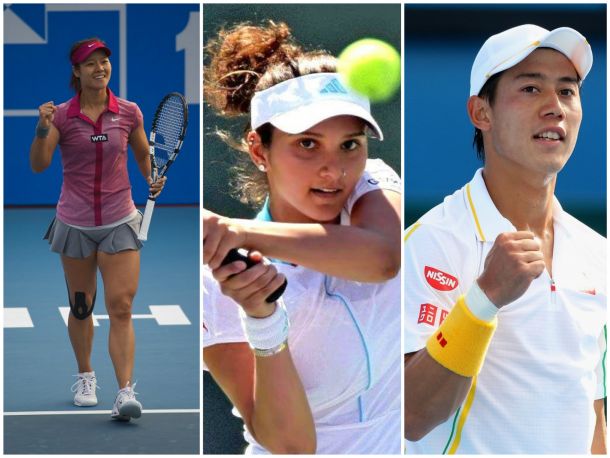Tennis is somewhat of an afterthought of a sport on the continent of Asia. For being the most populated continent, it never has seen a star of their own shine on the brightest stages of tennis, until 2011. 2011 is the year Li Na from China made her major breakthrough and won her first major. Li's rise gave Asia it's first true tennis star, and it would also coincide with the rise of the Japanese star, Kei Nishikori. Let’s also not forget about Sania Mirza, who has done a phenomenal job in doubles becoming the first Indian woman to ever reach a world number one ranking continuing the impact made on Asian tennis.
The 2014 season was Nishikori's breakout season. which saw him make the US Open final and an appearance at the Barclays ATP World Tour Finals. These two superstars on the singles circuit have their own similarities: champions, career-high rankings inside the top five, and having backhands as their best shot, but more than that, they are impacting tennis on a continental and global basis. Sadly, Li Na decided to retire last year, but the impact she has made on and off the court will surely never be forgotten. Together in the next ten years, Li and Nishikori can make Asian tennis more than just prominent, they can turn them into Grand Slam contenders.
Li Na who hails from China is the original pioneer and trailblazer of Asian tennis. It was more than just her on-court success that made her a pioneer, her charming personality and witty sense of humor made the public fall in love with her. In 2010, Li Na made her first major semifinal, and because of that she became the first Chinese women ranked in the top ten. Immediately the next year, she made an impact once again reaching the Australian Open final becoming the first Asian women to achieve the feat. Five months later, history was made once again as Li won the French Open and her popularity grew exponentially.
For three years, Li would consistently be ranked around the top five and was a major contender for the majors making a couple Australian Open finals and a US Open final. Last year, Li Na became the first Asian male or female to win the Australian Open known as the Grand Slam of Asia/Australia. Following the victory, Li gave one of the most memorable post-match speeches of all time (video below), where her charm and humor once again shone making the whole arena laugh.
However, the rest of 2014 was difficult for Li as she endured knee injuries and a dip in form which caused her to announce her retirement in September. The retirement of Li saw the loss of one of the most beloved personalities on the WTA circuit. Although Li has retired, she still has a significant impact on the game of tennis as she looks to continue to grow the game of tennis in China with her own tennis academy there. Also, she started up a tournament in her hometown in Wuhan and many more tournaments have followed. Li is followed by Peng Shuai, Saisai Zheng, Qiang Wang, and Shuai Zhang. Li's impact on the game of tennis in Asia, especially in China, has been overwhelming. Children look up to her as a role model, and they hope to continue the success she has brought upon the Asian tennis community.
The other woman we’re about to talk about is succeeding on the doubles circuit, and her name is Sania Mirza. Last year was what many thought was her best season to date. She was a mixed double runner-up at the Australian Open and won the mixed doubles title at the US Open. In Premier Mandatories and Premier 5 events, her and her partner, Cara Black, finished runners-up three times, but they became the bride rather than the bridesmaid with a title at WTA Year-End Championships.
Without Cara Black for most of this season, Mirza decided to pair up with Swiss legend Martina Hingis. We guess it’s fair to say their season is a success winning three titles already in their short partnership. As we have alluded to earlier, Mirza reached the world number one ranking after a title in Charleston. The impact she has made may not be as grand as the other two, but her success will be looked upon by many other Indians, men and women alike, and see that they can succeed on the tennis courts.
Li Na has a male counterpart to continue upon the booming impact she has made on the Asian tennis community, and that man is Kei Nishikori. In comparison to Li Na, he has achieved much less on-court success, but has had nearly the same impact as her. During the early part of Kei's career, the goal was to at least complete Project 45, which is surpassing the highest ranking by a Japanese man at forty-six by Shuzo Matsuoka. However due to Nishikori's massive potential, Nick Bollettieri, head of the IMG Academy, said the project should be changed to Project 10.
2012 saw Kei Nishikori make his biggest splash at a major at the time being quarterfinals appearance at the Australian Open becoming the first Japanese man to reach the Aussie Open quarterfinals. As previously mentioned, last year was Nishikori's breakout year. Nishikori made a coaching move to start 2014, and that was the hiring of French Open champion, Michael Chang. Chang's French Open title initially set off a small wave of popularity of tennis in Asia, but the impact was clearly not as big as Nishikori's or Li's.
The year started off with a semifinal appearance in Miami and followed that up with a finals appearance at the Masters 1000 in Madrid where he retired in the third set of the final because of a back injury. His year was highlighted by his first ever Grand Slam finals appearance at the US Open where he lost to Marin Cilic. Following the US Open, he won the Tokyo Open and played his way into the semifinals of ATP World Tour Finals finishing the year ranked fifth.
Obviously, Project 10 is clearly surpassed, but Nishikori's next project is to win a Grand Slam title and reach world number one. The Nishikori Effect is in full swing in Japan as its tennis infrastructure continues to be a strong point. As the Nishikori brand grows, more sponsors will be attracted, more events will be attended, and most importantly, more tennis players will try and bring more success to Japan and Asia. That is evident today as 18 year-old Hyeon Chung from Korea is in the top 100 of the ATP rankings. Growing up, he probably saw the likes of Roger Federer and Rafael Nadal succeed, but now seeing Kei Nishikori thrive has given him hope that he can become a champion one day just like him. Nishikori, Mirza, and Li are more than just tennis players and champions, they are pioneers into the evolving success of Asian tennis.








































